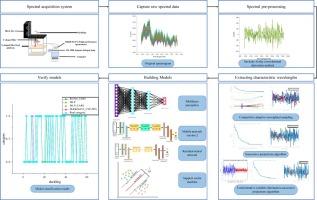基于近红外光谱波长选择和深度学习的鸭苗雌雄信息非破坏性检测
IF 3.4
3区 物理与天体物理
Q2 INSTRUMENTS & INSTRUMENTATION
引用次数: 0
摘要
雏鸭性别鉴定技术有助于现代养鸭业增加收入和节约成本。然而,传统的人工鉴定技术需要较高的技术水平,劳动强度大。本研究利用近红外光谱和深度学习算法,提出了一种非破坏性、用户友好和高效的雏鸭性别鉴定技术。研究收集了 600 组新孵化小鸭的光谱数据。这些数据按 7:2:1 的比例分为训练集、测试集和验证集。使用萨维茨基-戈莱卷积导数法对原始光谱数据进行预处理,用于随后的光谱特征波长提取和建模。特征波长的提取采用了竞争性自适应再加权采样(CARS)、连续投影算法(SPA)和结合 SPA 的无信息变量消除法(UVE-SPA)。研究并比较了传统的机器学习方法--支持向量机(SVM)和不同的深度学习模型,包括多层感知器(MLP)、移动网络版本 2(MobileNetV2)和残差神经网络(ResNet)。实验结果表明,深度学习算法的分类性能优于传统的光谱分析模型。此外,在构建分类模型之前进行特征波长提取可以减少模型的测试时间,甚至提高分类性能。最后,利用验证集对分类性能较好的四个模型进行了验证,最终选择 MobileNetV2 模型 UVE-SPA 组合作为小鸭性别鉴定的优化模型,其分类准确率为 98.3%,平均验证时间为 1.1 ms。综上所述,利用近红外光谱和 MobileNetV2 建立的检测模型可以实现对小鸭性别的无损识别。该研究结果可为后续相关在线智能检测系统的设计提供初步研究基础和技术支持。本文章由计算机程序翻译,如有差异,请以英文原文为准。

Non-destructive detection of male and female information in ducklings based on near-infrared spectral wavelength selection and deep learning
The technology for sex identification in ducklings can contribute to increased revenue and cost savings in modern duck farming. However, traditional manual identification techniques require high skill levels and involve significant labor intensity. In this study, a non-destructive, user-friendly, and efficient duckling sex identification technique was proposed using near-infrared spectroscopy and deep learning algorithms. Spectral data from 600 groups of newly hatched ducklings were collected. These data were divided into training, testing, and validation sets in a ratio of 7:2:1. The raw spectral data was preprocessed using the Savitzky-Golay convolution derivative method, which was employed for subsequent spectral feature wavelength extraction and modeling. The characteristic wavelengths were extracted using competitive adaptive reweighted sampling (CARS), successive projections algorithm (SPA), and uninformative variable elimination combined with SPA (UVE-SPA). Conventional machine learning methods − support vector machine (SVM) and different deep learning models, including multilayer perceptron (MLP), mobile network version 2 (MobileNetV2), and residual neural network (ResNet), were studied and compared. The experiment showed that deep learning algorithms outperform traditional spectral analysis models in terms of classification performance. Furthermore, conducting feature wavelength extraction before constructing the classification model could reduce the model’s testing time and even improve its classification performance. Finally, the four models with better classification performance were validated using a validation set, and the combination of MobileNetV2 model UVE-SPA was selected as the optimized model for ducklings’ gender determination, with a classification accuracy of 98.3 % and an average validation time of 1.1 ms. In summary, the detection model established using near-infrared spectroscopy and MobileNetV2 can achieve non-destructive identification of the gender of ducklings. The findings can provide a preliminary research foundation and technical support for the subsequent design of related online intelligent detection systems.
求助全文
通过发布文献求助,成功后即可免费获取论文全文。
去求助
来源期刊
CiteScore
5.70
自引率
12.10%
发文量
400
审稿时长
67 days
期刊介绍:
The Journal covers the entire field of infrared physics and technology: theory, experiment, application, devices and instrumentation. Infrared'' is defined as covering the near, mid and far infrared (terahertz) regions from 0.75um (750nm) to 1mm (300GHz.) Submissions in the 300GHz to 100GHz region may be accepted at the editors discretion if their content is relevant to shorter wavelengths. Submissions must be primarily concerned with and directly relevant to this spectral region.
Its core topics can be summarized as the generation, propagation and detection, of infrared radiation; the associated optics, materials and devices; and its use in all fields of science, industry, engineering and medicine.
Infrared techniques occur in many different fields, notably spectroscopy and interferometry; material characterization and processing; atmospheric physics, astronomy and space research. Scientific aspects include lasers, quantum optics, quantum electronics, image processing and semiconductor physics. Some important applications are medical diagnostics and treatment, industrial inspection and environmental monitoring.

 求助内容:
求助内容: 应助结果提醒方式:
应助结果提醒方式:


